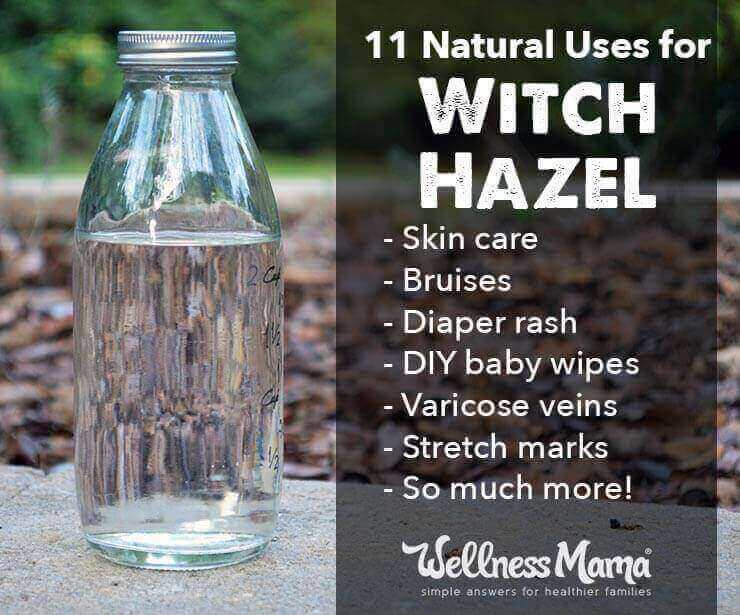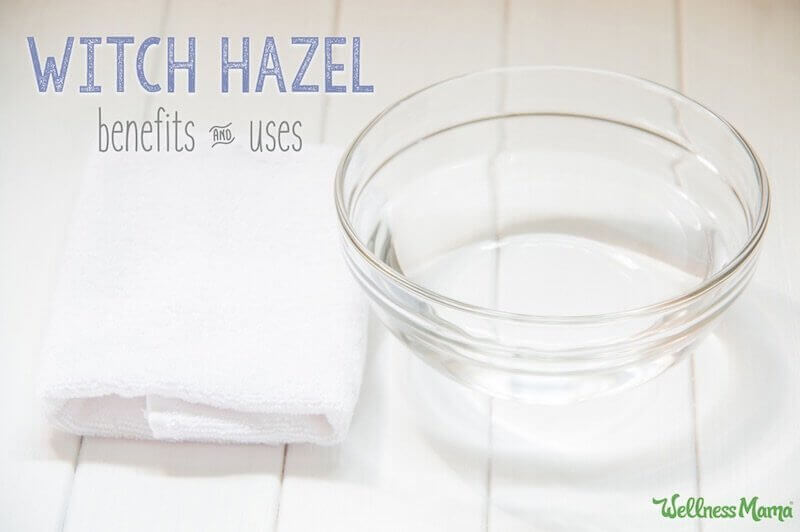My first introduction to witch hazel was not a pleasant one. I remember when I was given a container of witch hazel pads after the many hours of pushing that led to the eventual birth of my firstborn. As I sat there on my ice pack and felt pain in places I didn’t know could feel pain, a rather stern nurse gave me a primer on what hemorrhoids were, how they could occur after birth, and what to do about them…
Thankfully, I never needed those pads, but the whole experience turned me off to witch hazel.
Fast forward a few years, and I was making the switch to cloth diapers. I wanted to find a natural alternative to regular baby wipes, and in my research on baby-safe ingredients I once again stumbled upon witch hazel.
I decided my prejudice might not be quite fair, and took a second look.
What Is Witch Hazel?
When I started researching it surprised me to learn that witch hazel isn’t just a remedy given to new moms. Also called hamamelis distillate (from its Latin name hamamelis virginiana), this plant-based substance has been used for centuries both medicinally and in skincare and beauty products. It is a chiefly an external remedy applied to the skin. (Although there is such a thing as witch hazel tea, I haven’t tried it yet.)
Witch hazel extract is a a natural astringent or hydrosol made from the bark of the witch hazel shrub or tree. While many of the herbs, spices, and other natural remedies I cover seem to all come from exotic lands, the witch hazel tree is native to North America. The Native American Indians in the northeast especially often used witch hazel for as a healthy remedy and for various skin problems.
There are two methods to getting extract from witch hazel bark: 1) as a distillation (commonly found in stores, with some type of alcohol added as a preservative) or 2) as a decoction, similar to this method for making herbal tinctures. Some herbalists say the decoction method makes a more concentrated version with higher levels of tannins, the component that gives witch hazel its astringent properties, but the distilled version is more shelf-stable.
If you don’t feel like making your own, there are better store-bought options that are double-strength distilled.
Benefits of Witch Hazel
Now that I’ve gotten over my first bad impression, I use witch hazel at home in a whole variety of ways. It is a staple in my natural home remedy kit for first aid and skin care, as it’s handy for everything from soothing minor skin irritations to removing makeup.
Here are some of my favorite ways to use it:
1. Natural Skincare
As mentioned, witch hazel is a multi-purpose remedy that can help with a wide variety of skin conditions. Many people apply it with a cotton pad to cleanse the face and for its astringent properties, which tighten and tone the skin. Apply it to soothe skin disorders like psoriasis, blemishes from acne, or just general dry skin and itching. This isn’t just folklore or wishful thinking, either… studies like this one explain how its natural anti-inflammatory and antioxidant properties work.
I like to use it in this homemade vitamin C facial toner recipe, which has been great for my naturally oily skin.
2. Postpartum
Witch hazel is often recommended post-childbirth (hopefully by a friendlier nurse or midwife than the one I had) because it makes a great postpartum healing spray for the perineum. I make a tincture of witch hazel extract and after-birth herbs that I keep in a spray bottle for post-birth soothing.
It is also possible to make a homemade version of the pads often handed out in hospitals by pouring natural witch hazel over organic cotton pads (and even adding herbs or aloe for additional soothing).
3. For Stretch Marks
I haven’t tried it personally, but a friend was able to make her stretch marks almost completely disappear by spraying witch hazel extract on them once a day for a few months. I recommend this treatment along with dry brushing and this stretch mark salve. Dry brush before a shower, and apply witch hazel after and let dry on the skin. Then apply the stretch mark cream. The toning action of the witch hazel along with the moisturizing salve treatment should go a long way to improve skin.
4. Diaper Rash and Baby Wipes
Witch hazel is an ingredient in my homemade baby wipes (that can be made using cloth wipes or with a disposable option) because it is excellent for the skin. Combined with aloe, it has been very soothing on my little ones. Witch hazel is also great for diaper rash, and I keep a small bottle and some organic cotton balls in my diaper kit as a quick remedy.
5. Varicose Veins
Another remedy I haven’t personally tried, but a midwife friend recommends, is a compresses for varicose vein relief. Soak cloths in witch hazel to make compresses and apply to the legs to reduce the discomfort of varicose veins.
6. For the Hair (Anti-Dandruff)
The same properties that make witch hazel beneficial to the skin also make it good for the hair and scalp. I’ve used it pre-shampoo to help add shine to my hair and de-frizz, but this same process can help with dandruff. I keep a spray bottle of witch hazel in the bathroom to spray on the scalp before showering and then wash out in the shower.
7. Single-Ingredient Deodorant
I love my homemade deodorant, but baking soda can be irritating to some people. A magnesium-based spray deodorant can be a great alternative, but for especially sensitive skin, plain witch hazel (or add a few drops of lavender essential oil) can be a great alternative. I also recommend trying an armpit detox to reduce odor and make armpits less sensitive.
8. Itch Remedy
I keep witch hazel in the first aid kit for treating all kind of itching. It can be really helpful in reducing the itch from chickenpox, eczema, poison ivy, and bug bites.
In fact, I keep a small glass bottle of witch hazel and lavender in the first aid kit, and my children will go find this and use on bug bites or skin itching if they need it. I also make an anti-itch cream using it that is great for spot treating itchy areas.
9. Bruise Spray
Just as it can sooth varicose veins, witch hazel can help reduce the appearance and pain of a bruise. I learned this firsthand when I managed to turn around into the side of a kitchen cabinet and give myself a big forehead bruise the week before a family wedding. A witch hazel compress once a day helped vanish the bruise within a few days.
10. Sunburn or Razor Burn
Apple cider vinegar is my go-to for sunburn, but witch hazel also works well. Keep a spray bottle of it cold in the fridge for cooling relief for a sunburn. It even helps reduce swelling or irritated skin from razor burn after shaving.
11. In Bug Spray
Witch hazel is the base for my homemade bug spray. It is an excellent base for the dried herbs or essential oils in DIY bug spray and adds lots of skin benefits of its own. Since it is also helpful for itchy skin and even poison ivy, it is a good duel-purpose remedy for camping or beach trips. (Even use it on insect bites… but if you apply this bug spray, you shouldn’t need that tip!)
12. On Minor Cuts
Since the tannins in witch hazel work to tighten the skin, they can also help promote healing and stop bleeding on a minor cut. This is the same action that makes it useful for hemorrhoids and skin irritations. (Just make sure not to use the kind with added alcohol, or it will sting.)
Finding Good Quality Witch Hazel
Many store-bought brands contain more alcohol than witch hazel and can be drying or sting sensitive skin. I always buy this brand, which is double-distilled and more potent than most store-bought options.
Ever used witch hazel? What do you use it for?




Leave a Reply